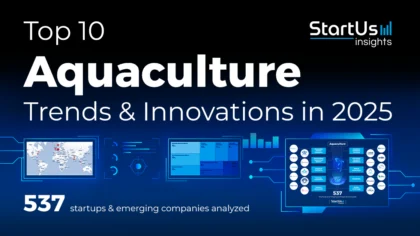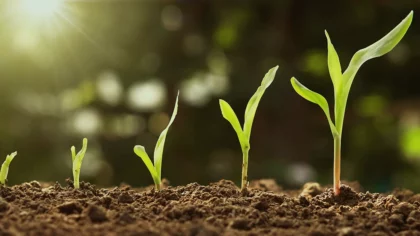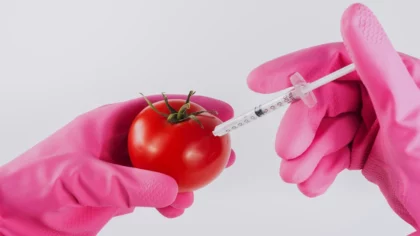Accelerate Productivity in 2025
Reignite Growth Despite the Global Slowdown
Irrigation technology trends in 2025 are driving a smarter, data-centric shift in agriculture, landscaping, urban greening, and more. As global pressure mounts to conserve water and increase yields, these trends encourage farmers with real-time insights, adaptive control, and scalable automation.
Presently, the water supply and irrigation market is projected to grow from USD 408.35 billion in 2025 to USD 532.39 billion in 2029 at a compound annual growth rate (CAGR) of 6.9%.
This report serves as a strategic guide for technology developers, innovators, urban planners, sustainability advocates, policymakers, and researchers working toward innovative irrigation ecosystems.
What are the Top 10 Irrigation Innovation Trends in 2025?
- Internet of Things (IoT) Integration
- Drones and Robotics
- Artificial Intelligence (AI) Integration
- Solar Irrigation
- Micro and Drip Irrigation Expansion
- Fertigation Integration
- Climate-Resilient Irrigation
- Water Recycling and Reuse Systems
- Sustainable Materials and Circular Systems
- Decentralized Infrastructure
Methodology: How We Created the Irrigation Industry Trend Report
For our trend reports, we leverage our proprietary StartUs Insights Discovery Platform, covering 7M+ global startups, 20K technologies & trends plus 150M+ patents, news articles, and market reports.
Creating a report involves approximately 40 hours of analysis. We evaluate our own startup data and complement these insights with external research, including industry reports, news articles, and market analyses. This process enables us to identify the most impactful and innovative trends in the irrigation industry.
For each trend, we select two exemplary startups that meet the following criteria:
- Relevance: Their product, technology, or solution aligns with the trend.
- Founding Year: Established between 2020 and 2025.
- Company Size: A maximum of 200 employees.
- Location: Specific geographic considerations.
This approach ensures our reports provide reliable, actionable insights into the irrigation innovation ecosystem while highlighting startups driving technological advancements in the industry.
Innovation Map outlines the Top 10 Irrigation Trends & 20 Promising Startups
For this in-depth research on the Top Irrigation Trends & Startups, we analyzed a sample of 970+ global startups & scaleups. The Irrigation Innovation Map created from this data-driven research helps you improve strategic decision-making by giving you a comprehensive overview of the irrigation industry trends & startups that impact your company.
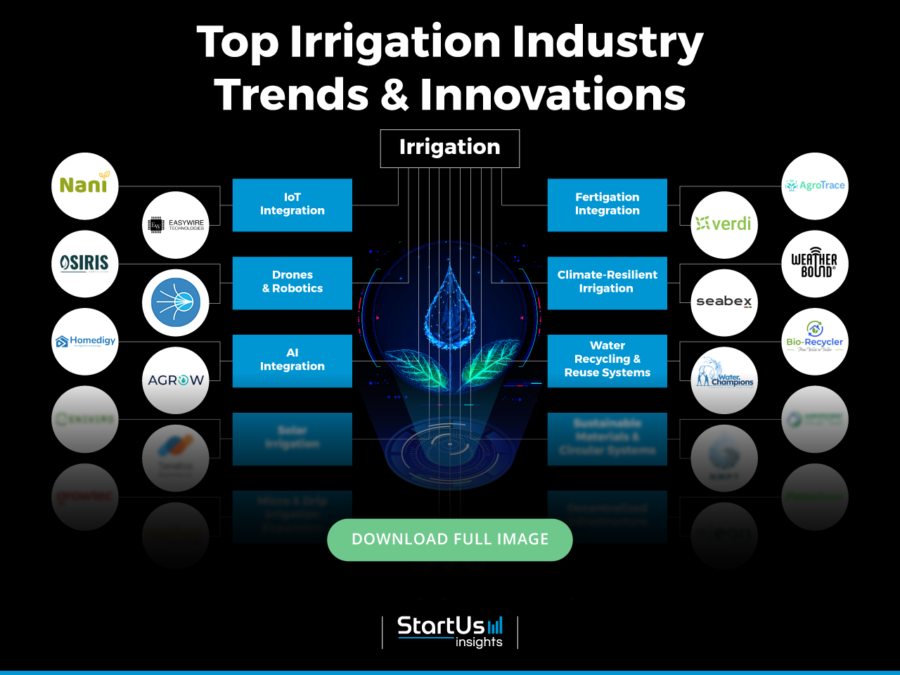
Tree Map reveals the Impact of the Top 10 Irrigation Trends
Irrigation providers adopt intelligent systems to address water scarcity, labor shortages, and climate variability. IoT-enabled sensors and AI-powered platforms deliver real-time insights. Drones and robotics automate monitoring, spraying, and leak detection.
Solar irrigation systems lower energy costs and extend access to off-grid regions, while micro and drip irrigation expand to maximize precision and minimize runoff. Fertigation technologies also merge nutrient delivery with watering cycles for better crop performance.
Additionally, climate-resilient irrigation systems adapt to shifting weather patterns, and water recycling innovations reduce reliance on freshwater sources. Sustainable materials and circular models reimagine irrigation infrastructure. While decentralized solutions localize water treatment, distribution, and reuse, they allow farms and remote communities greater control, flexibility, and resilience.
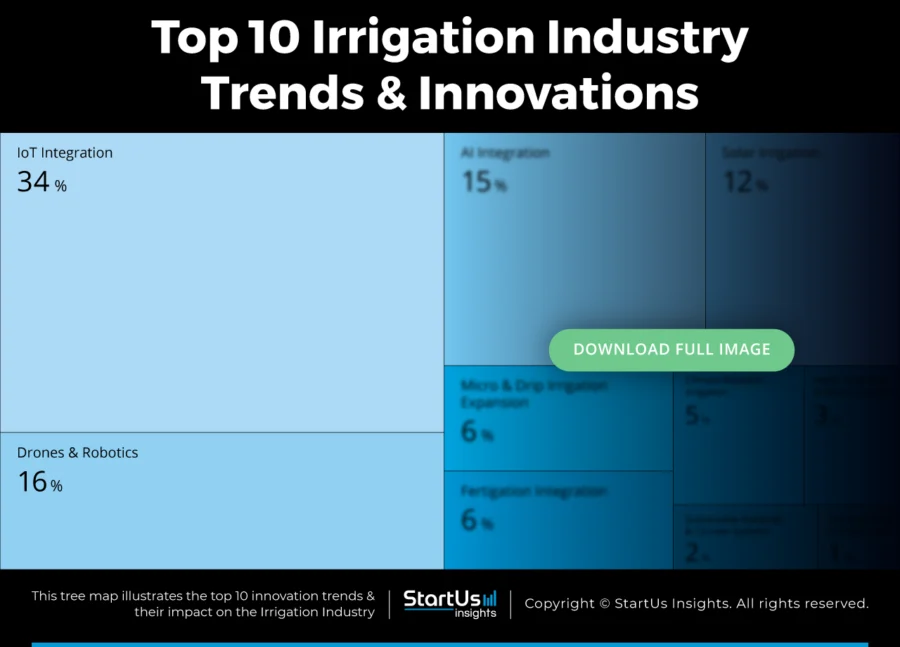
Global Startup Heat Map covers 970+ Irrigation Startups & Scaleups
The Global Startup Heat Map showcases the distribution of 970+ exemplary startups and scaleups analyzed using the StartUs Insights Discovery Platform. It highlights high startup activity in the USA and India, followed by Australia. From these, 20 promising startups are featured below, selected based on factors like founding year, location, and funding.
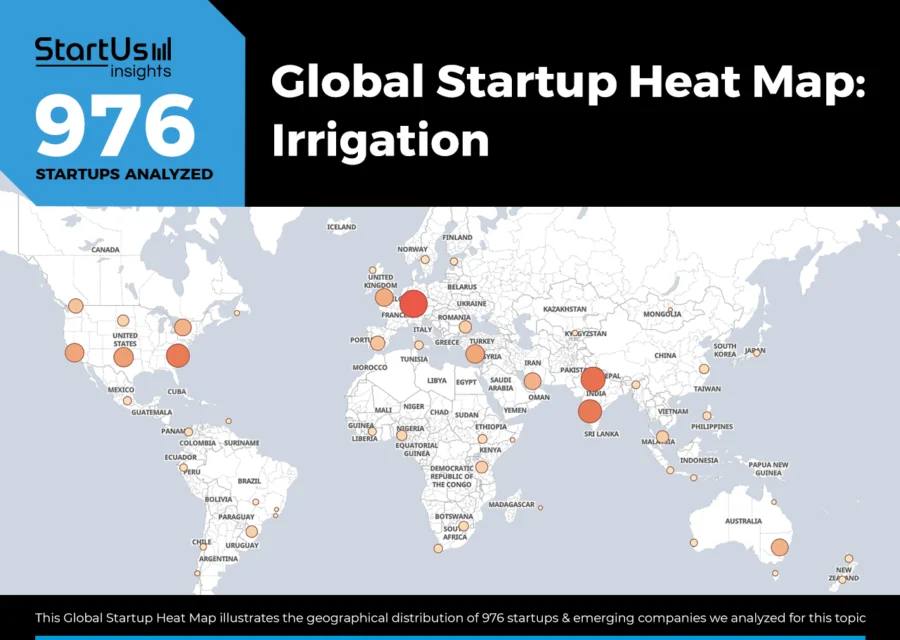
Want to Explore Irrigation Innovations & Trends?
Top 10 Emerging Irrigation Trends [2025 and Beyond]
1. IoT Integration
The irrigation industry is rapidly integrating IoT technologies to address global water scarcity, reduce environmental impacts, and meet rising agricultural demands.
Agriculture uses nearly 70% of the world’s freshwater, with up to half lost to inefficient watering practices. IoT-based irrigation addresses this loss by enabling real-time monitoring and automated control.
By embedding sensors, automation, and data connectivity into irrigation systems, farms manage water more precisely and efficiently.
Governments across India, China, and Europe also back this shift with subsidies and climate-aligned policies that promote smart irrigation adoption. These initiatives support the sustainability development goals (SDG) 6 by encouraging farmers to digitize water use.
Smart irrigation systems conserve 30-50% more water than conventional methods. They also increase yields by 20% through precise scheduling.
IoT devices also continuously collect weather and soil data for systems to make adaptive irrigation decisions. Cloud-connected dashboards further provide real-time insights for farmers to adjust operations remotely.
Moreover, precision irrigation, powered by IoT and AI, automates scheduling for row crops. Smart greenhouses integrate IoT sensors to maintain stable humidity, light, and temperature conditions.
On large-scale farms, centralized IoT networks manage water use across acres. Even in residential landscaping, IoT-connected sprinklers, like Rachio, automatically adjust watering based on local forecasts.
Additionally, connectivity protocols such as long-range wide area network (LoRaWAN), narrowband internet of things (NB-IoT), and 5G ensure reliable real-time data flow across vast and remote agricultural areas.
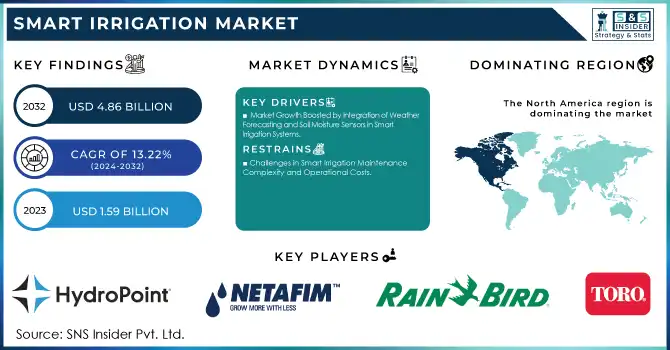
Credit: S&S Insider
The global smart irrigation market is projected to reach USD 4.86 billion by 2032. The global expansion is driven by rising adoption of IoT-powered systems that enable data-informed water management across farms, greenhouses, and urban landscapes.
Nani manufactures an IoT-based Automatic Water Pump
Indonesian startup Nani creates an IoT-based automatic water pump system that simplifies irrigation for rice farmers. It uses an ESP32 microcontroller to automate pump operations based on scheduled inputs and water usage data.
Additionally, the system connects to the cloud via Wi-Fi or 2G and allows farmers to manage irrigation remotely through a mobile phone. It also integrates a water volume sensor to monitor consumption in real-time.
Further, the water pump system integrates with existing pumps and sprinklers to deliver targeted water flow.
The startup provides efficient irrigation and increases crop productivity through smart farming by combining automation and remote control.
EasyWire Technologies offers Smart IoT Irrigation Control
Indian startup EasyWire Technologies develops IoT-based irrigation controllers that upgrade conventional farming systems with remote monitoring and intelligent control.
Its product, Controller Lite, an IoT-based pump controller, integrates with existing motor starters to automate pump operations. The Smarter Starter, another IoT-enabled controller, connects directly to 3-phase power and eliminates the need for separate starters.
Both devices use IoT connectivity to enable real-time control and scheduling through mobile interfaces. This allows farmers to manage water use more precisely.
Moreover, the controllers support smooth installation and improve irrigation efficiency by aligning pump activity with crop and soil needs.
Drones and Robotics
Robots and drones are essential in irrigation as climate volatility, water scarcity, and labor shortages intensify. These technologies address key challenges like uneven water distribution and crop stress detection by improving water-use efficiency and enabling precise, data-driven irrigation.
Additionally, tightening sustainability mandates and precision agriculture policies incentivize farmers to adopt technologies that provide inputs more accurately and reduce environmental impact.
Drones and ground robots offer irrigation and nutrients with high precision. For instance, DJI‘s Agras spray drones apply water only where needed, as the drones are guided by real-time sensor data. Such drones also provide detailed field intelligence.
Unmanned aerial vehicles (UAVs) equipped with multispectral and thermal cameras also generate high-resolution plant stress maps. UAVs guide variable-rate irrigation (VRI) systems nozzle by nozzle.
For example, robots like Purida‘s orchard sprayer and John Deere‘s AI-powered See & Spray Ultimate reduce water and chemical use through targeted applications.
Real-time kinematic global positioning system (RTK-GPS) and light detection and ranging (LiDAR) enable robots to localize plant positions accurately. This is essential for operating around drip lines or in dense crop rows.
Solid-state actuators, micro-valves, and low-power wide-area (LPWAN) networks, like long range (LoRa) and NB-IoT, maintain low-energy, high-density field connectivity. This enables drones and robotic irrigation systems to operate autonomously and provide precise water or nutrient doses.
Meanwhile, convolutional neural networks process satellite imagery, weather data, and soil conditions to automate irrigation decisions. Drones and robotics capture real-time aerial and ground-level data that feed these models. This way, drones and robotic systems increase the accuracy and responsiveness of precision irrigation systems.
Market growth reflects this momentum. The agriculture drone market is set to grow from USD 6.1 billion in 2024 to USD 23.8 billion by 2032. This surge is also driven by the use of drones in irrigation that use aerial imaging and autonomous systems to monitor soil and deliver water with precision.
Osiris Agriculture develops Autonomous Agricultural Robots
French startup Osiris Agriculture offers Oscar, an autonomous robotic system that manages irrigation for large industrial crop fields.
Oscar stays in the field throughout the season, navigates plots daily, and delivers precise amounts of water based on real-time crop needs. It uses AI to analyze plot-specific data and adjusts irrigation to match local conditions.
Additionally, the robot reduces manual labor, secures yields against climate variability, and lowers input usage to minimize environmental impact.
The startup uses robotics and AI to deliver a full-service irrigation system that streamlines farm operations and supports agroecological farming.
TerraRad Tech applies Passive Microwave Technology
Swiss startup TerraRad Tech deploys PoLRa, a portable passive-microwave radiometer that mounts on drones and utility robots to map subsurface soil moisture while machines traverse fields.
The sensor captures naturally emitted microwaves 14 times per second at a depth of 10 cm, then geotags each reading via global positioning system (GPS) for high-resolution moisture mosaics.
Moreover, dual-polarization optics, 0.14 K radiometric resolution, and a 4 W power draw ensure precise data and solar-friendly autonomy. Whereas the startup’s Extreme PoLRa safeguards performance during harsh weather conditions. Pypolra, an open Python processing suite, converts brightness temperatures into geographic tagged image file format (GeoTIFF) grids and comma-separated values (CSV) points for streamlined analysis.
Consequently, growers and turf managers adopt variable-rate irrigation, slash water use, and maintain uniform crop or turf conditions through informed robot-enabled decisions.
3. AI Integration
AI is changing irrigation as farms face mounting pressure from water scarcity, rising food demand, and new policy mandates. Agriculture uses about 70% of global freshwater, while food production must rise by over 56% by 2050 to feed the growing population’s needs sustainably.
AI-driven irrigation addresses these challenges by optimizing when and how much water crops receive. For instance, AI platforms integrate data from IoT-enabled soil moisture probes, weather stations, and flow meters. They apply machine learning (ML) algorithms to predict evapotranspiration and adjust irrigation schedules in real time.
Moreover, AI detects leaks, flags faulty irrigation zones, and identifies early plant stress. Computer vision models analyze leaf coloration, canopy health, and soil moisture distribution to fine-tune irrigation volumes per crop zone.
AI-powered digital twins simulate irrigation outcomes under various weather and soil conditions. Predictive analytics further allows farmers to anticipate pump failures or weather shifts and minimize disruptions.
AI-integrated supervisory control and data acquisition (SCADA) systems also automate water delivery based on real-time inputs. Neural networks process multispectral images to monitor crop hydration levels. CropX, for instance, offers AI-based irrigation recommendations using field-level soil data, while Taranis uses aerial imagery and ML to manage irrigation.
Homedigy delivers AI-powered Precision Soil Moisture Sensing
US-based startup Homedigy builds GeoDrops, an AI-powered soil sensor system that automates irrigation based on real-time soil conditions.
The soil sensor system uses capacitive displacement sensing to measure full volumetric soil moisture across all soil types.
Each GeoDrops sensor functions as an edge computer that processes data locally and sends it to the GeoDrops cloud. The cloud engine runs a self-learning soil physics model that updates watering recommendations using continuous environmental input.
GeoDrops learns from every use, eliminates manual calibration, and integrates with existing irrigation systems or supports manual watering.
The startup further embeds predictive AI and edge computing into soil sensing to deliver a precise irrigation system. This system conserves water and improves plant health through real-time, adaptive control.
Agrow Analytics provides an AI-driven Integrated Irrigation Management Platform
Spanish startup Agrow Analytics builds an AI-driven irrigation optimization platform that unifies diverse agricultural data to guide precise water use.
The platform connects with existing irrigation systems and gathers inputs such as soil conditions, weather, and crop type into a single interface. It analyzes this data to generate sector-specific recommendations on where, when, and how much to irrigate.
Moreover, the platform reduces the water footprint, reduces energy consumption, and increases equipment efficiency.
The startup centralizes spatiotemporal irrigation data and automates decisions to support precise water use. It allows producers and agronomic advisors to improve yields and lead sustainable water management across stressed watersheds.
4. Solar Irrigation
Solar-powered irrigation addresses challenges such as rising fuel costs, unreliable electricity access, and carbon footprint.
For instance, India’s PM-KUSUM program subsidizes installation costs, which encourages widespread adoption among farmers. Once installed, solar pumps eliminate recurring fuel or electricity bills and reduce irrigation energy costs.
Solar irrigation systems also increase crop yields by providing reliable daytime water access, particularly important in drought-prone or off-grid regions. For example, smallholder farmers in Ethiopia use solar pumps to irrigate dry-season crops. This ensures food production even during water shortages.
Moreover, photovoltaic (PV) panels convert sunlight into electricity to run direct current (DC) or alternating current (AC) pumps. The addition of newer high-efficiency modules further reduces costs and improves power output.
Specialized solar water pumps that are submersible for deep wells and surface pumps for ponds operate directly on solar power. These pumps have built-in controllers to match variable solar input. Battery energy storage systems (BESS) and elevated water tanks store excess energy or water to irrigate during cloudy weather or at night.
Further, hybrid solar irrigation setups combine solar with grid or diesel backup for continuous irrigation in cloudy regions. Cloud-based platforms and IoT-enabled controllers automate irrigation schedules and adjust flow rates using real-time data from soil moisture sensors and weather forecasts.
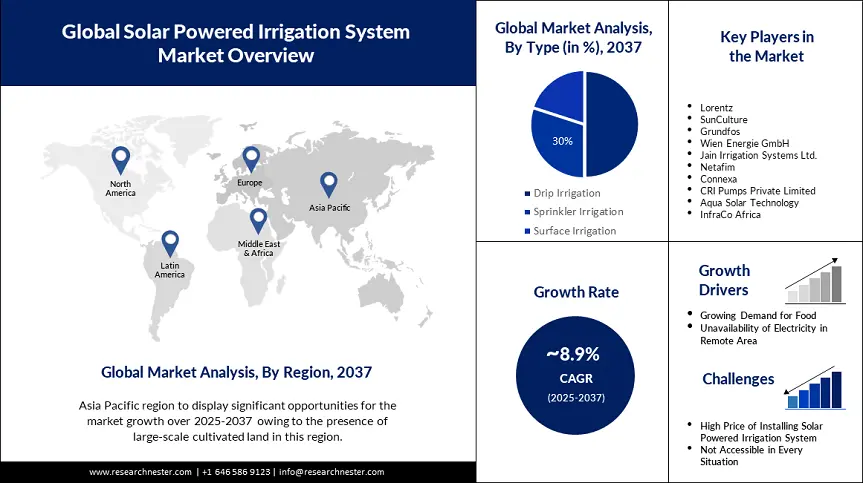
Credit: Research Nester
With this, the global solar-powered irrigation market is projected to grow up to USD 211.97 billion by 2037. This expansion is driven by rising food demand, decarbonization targets, and ongoing innovations in solar and digital irrigation technologies.
ENEVERD builds Solar-powered Water Pumping System
Syrian startup ENEVERD designs Agri-PV solutions that generate solar power to support agricultural irrigation and greenhouse operations.
The startup integrates PV panels with high-efficiency pumping inverters to convert solar energy into usable power for water pumps and environmental control systems.
Additionally, the startup installs on-grid, off-grid, or hybrid systems based on land characteristics and system requirements. It uses high-quality panels and protection devices such as surge protectors, circuit breakers, and isolators.
The startup powers irrigation pumps directly from solar energy, reduces energy costs, and improves water use efficiency.
It also combines solar energy with irrigation infrastructure to extend growing seasons, stabilize yields, and reduce reliance on conventional power sources.
TerraEco Dynamics manufactures a Solar-powered Portable Micro Pump
Indian startup TerraEco Dynamics designs solar-powered precision irrigation systems that use IoT-enabled sensors and micro-pumps to optimize water delivery in agriculture.
The startup combines portable solar micro-pumps with moisture, humidity, and temperature sensors to collect real-time field data and transmit it to an IoT hub for analysis.
It uses this data to supply water with pinpoint accuracy, ensuring each crop receives the right amount at the right time.
Moreover, the startup designs the system to operate fully off-grid. This enables deployment in remote areas and reduces reliance on conventional energy sources.
The startup further integrates solar energy with real-time data and automation to improve irrigation efficiency, support small and marginal farmers, and advance sustainable agriculture.
5. Micro and Drip Irrigation Expansion
Micro and drip irrigation systems are expanding rapidly as a central trend in the irrigation field. This is driven by growing water scarcity and the need for greater efficiency in agricultural water use.
Farmers adopt these systems to apply water directly at the root zone and to reduce evaporation and runoff. This precision approach supports environmental sustainability by minimizing pollutant transport and preserving soil structure.
Compared to traditional flood irrigation, drip systems reduce water consumption while maintaining or even improving yields. The slow, targeted application prevents soil erosion and ensures consistent moisture delivery.
Consequently, crop yields and produce quality improve, especially in high-value crops such as fruits, vegetables, and berries. In row crops like maize, wheat, and cotton, drip irrigation increases productivity, with maize yield gains reaching up to 12.7%.
Additionally, these systems are also dominant in greenhouses, hydroponics, orchards, and plantations to provide precise and uniform water application at scale.
Regions facing chronic water shortages are turning to micro and drip irrigation to maintain agricultural output under drought conditions. The region’s ability to conserve water while supporting consistent yields makes it indispensable in climate-stressed regions.
Advanced technologies continue to expand this trend. Computer-aided design (CAD) and geographic information system (GIS) tools design optimized irrigation layouts. Likewise, IoT-enabled controllers paired with soil and salinity sensors automate watering based on real-time conditions.
Subsurface drip systems and mobile solutions, like Netafim‘s PMDI, extend reach across large fields. Cloud platforms also enable remote monitoring that drives micro- and drip irrigation expansion by making precision management widely accessible.
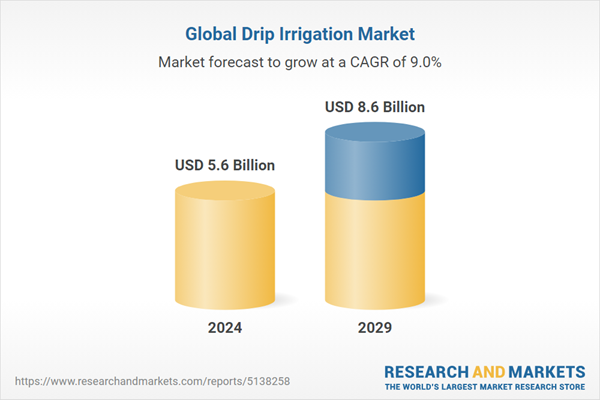
Credit: Research and Markets
The global drip irrigation market is projected to grow up to USD 8.6 billion by 2029 at a CAGR of 9%. The growing market size underscores the vital role micro and drip systems play in the future of irrigation.
Growtec Solutions designs Custom Drip Irrigation Systems
Canadian startup Growtec Solutions manufactures custom micro- and drip irrigation systems for greenhouse and hydroponic operations.
The startup integrates pressure-compensated drippers, adjustable flow rates, multiple outlet options, and no-drain features. These specifications offer precise and efficient water distribution tailored to each plant’s needs.
It also operates an in-house semi-automatic irrigation assembly line that produces high-quality polyethylene tubing and custom drip lines to match greenhouse layouts.
The startup further supplies irrigation fittings and accessories that enable growers to customize layouts and streamline water delivery for crops with different requirements.
SaranshIoTLabs offers a Mobile-operated Drip Irrigation System
Indian startup SaranshIoTLabs develops a mobile-operated drip irrigation application that provides precision watering for apartment and balcony gardens.
The startup equips existing drip setups with an IoT-enabled device that connects to local Wi-Fi and lets businesses control watering remotely through a mobile app.
It also enables real-time scheduling, supports multi-access, and manages remote activation or shutdown. While the app handles power outages and connectivity fluctuations.
Additionally, the app delivers water directly to plant roots and reduces both overwatering and waste.

6. Fertigation Integration
By combining water and nutrient delivery, integrated systems address water scarcity and improve resource efficiency while minimizing losses from leaching and runoff.
Fertigation systems support faster plant growth and higher yields. For example, maize trials show yield increases of up to 12.7% compared to traditional broadcast fertilization. These gains are particularly important as global food demand continues to rise.
High-value fruits and vegetables in greenhouses rely on continuous fertigation for consistency and quality. In open fields, crops like maize, wheat, cotton, and potatoes see yield gains. Controlled environments like hydroponics and vertical farms also use fertigation to ensure precise, year-round nutrient delivery in space- and water-limited settings.
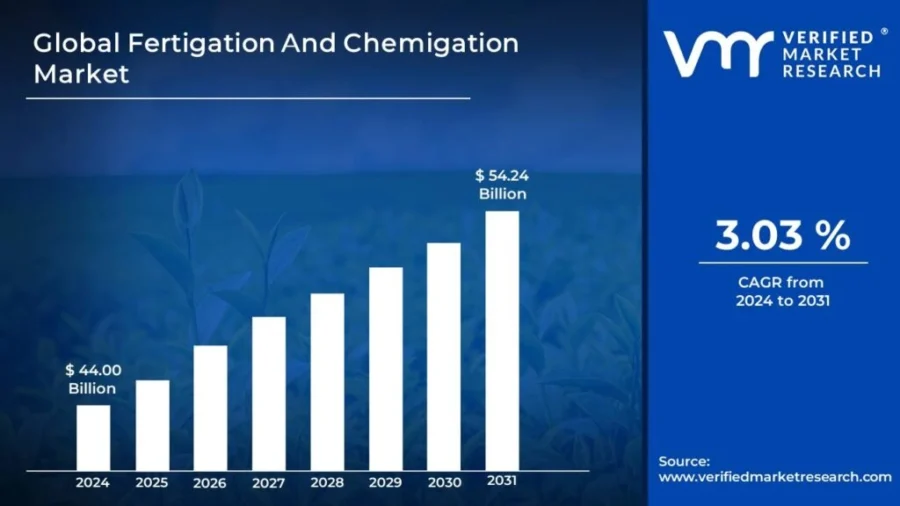
Credit: Verified Market Research
Presently, the global fertigation and chemigation sector is projected to reach USD 54.24 billion by 2031. This growth reflects increasing demand for integrated irrigation-nutrition systems that improve yields, reduce input waste, and support sustainable agriculture.
AgroTrace provides Soil Water Potential-based Fertigation Management
Indian startup AgroTrace creates an IoT-based solution for efficient irrigation and fertigation management that measures soil water potential and temperature at multiple depths.
The startup integrates WM200 sensors, which use gypsum blocks to simulate root behavior and accurately measure available soil moisture. It transmits sensor data via long-term evolution (LTE) networks.
Additionally, the startup’s proprietary AI algorithms analyze this data to assess real-time field conditions and determine precise water and nutrient requirements. With this, farmers monitor and adjust irrigation and fertigation strategies.
The startup further combines deep-soil sensing with fertigation planning to provide precise water and nutrient management. This reduces water waste, prevents nutrient leaching, and increases farm productivity through targeted resource use.
Verdi enables an AI-powered Variable Rate Fertigation Platform
Canadian startup Verdi provides a farm automation platform that integrates variable rate irrigation (VRI) and fertigation using AI-powered software, wireless hardware, and modular controls.
The startup retrofits existing valves, pumps, injectors, and sensors with weather-resistant block and micro-block controllers that operate entirely wirelessly. This enables row-level and sub-block precision in water and nutrient delivery.
It also transmits real-time data to a cloud-based dashboard, where farmers monitor field activity, adjust schedules, and verify pressure conditions remotely.
The platform further supports integration with third-party soil moisture sensors, weather stations, and imagery to increase data accuracy for fertigation decisions.
Additionally, Verdi designs its system to survive harsh farm environments and scale across thousands of devices.
7. Climate-Resilient Irrigation
As climate change intensifies droughts, floods, and temperature extremes, innovative irrigation systems play a central role in buffering crops against erratic rainfall and extreme weather.
Climate-resilient systems enable farms to stabilize output under pressure. For example, irrigated farms in Mali maintained steady productivity during extended heat waves. By improving canals, automating pumps, and upgrading on-farm storage, farmers respond quickly to weather shifts and reduce long-term risks.
Moreover, precision irrigation increases water-use efficiency while delivering consistent nutrients.
Automation adds another layer of resilience. Smart irrigation systems prevent over and under-watering. This saves up to 70% of water and improves crop quality, which is critical for farmers facing climate uncertainty.
In greenhouses, automated irrigation reduces labor and shields crops from extreme conditions. For example, community-owned solar-lift systems irrigate dry-season crops with clean energy in India. In Nepal and Afghanistan, traditional weirs are revived to safely divert floodwaters and protect fields.
Along with IoT and AI, satellite-based evapotranspiration monitoring also improves water allocation. SCADA systems and mobile apps support remote control and early warnings. Digital twins further enable businesses to simulate irrigation performance under climate stress.
The World Bank invested USD 7 billion in climate-smart irrigation, and the Asian Infrastructure Investment Bank (AIIB) approved USD 100 million for Cambodia’s adaptive systems. Likewise, the US Climate Resilience Regional Challenge allocated USD 575 million for water- and agriculture-related projects and initiatives. These projects and initiatives firmly position irrigation at the heart of climate adaptation.
Weatherbound deploys Smart Weather-integrated Irrigation System
Swiss startup Weatherbound provides a smart irrigation and farm insight monitoring system that increases climate resilience and water efficiency in agriculture.
The startup combines real-time soil sensors, weather data, and forecast models to calculate optimal water requirements and provide precise irrigation recommendations through a mobile application. It also offers optional automation via irrigation controller nodes that execute scheduled irrigation based on sensor inputs.
Additionally, the monitoring system sends push notifications to farmers, which enables timely decisions without infrastructure changes.
Alongside irrigation, the system provides advanced weather monitoring to support smarter planting, fertilizing, and harvesting strategies.
Seabex delivers Sensorless AI-driven Precision Irrigation
French startup Seabex builds a climate-resilient irrigation management platform that allows farmers to optimize water use through data-driven recommendations and real-time monitoring.
The startup integrates satellite imagery, weather forecasts, soil and crop data, and vegetation indices to estimate irrigation needs across multiple crop types and plot conditions.
Its Agrisense and Netirrig tools provide personalized irrigation schedules and water balance insights without requiring in-field sensors.
Moreover, businesses receive recommendations based on automatic zoning, weather-corrected data, and phenological stages via a web and mobile interface.
Seabex also enables automation through connected irrigation stations, which allows farmers to remotely control irrigation and improve precision.
8. Water Recycling and Reuse Systems
Water recycling and reuse systems are becoming essential in irrigation as regulations tighten, infrastructure ages, and freshwater resources grow scarce.
Governments enforce stricter discharge limits and sustainability mandates. This prompts farms and utilities to treat and reuse wastewater specifically for irrigation instead of relying on dwindling freshwater supplies.
Moreover, leaky pipelines and inefficient water delivery systems encourage the shift to localized reuse. This minimizes water losses and reduces the energy used for long-distance transport.
Treated wastewater offers a reliable, climate-independent supply for irrigation and lowers both pumping and extraction costs. Its residual nitrogen and phosphorus serve as natural fertilizers, directly supporting crop growth and reducing synthetic input use.
On-site reuse also prevents nutrient runoff from irrigated fields, protects downstream ecosystems, and sustains long-term soil health.
Reuse systems already irrigate farms, parks, golf courses, and urban green spaces and recharge basins that replenish groundwater resources critical for agricultural use.
Moreover, membrane bioreactors, reverse osmosis, and oxidation units treat wastewater to meet irrigation quality standards.
Struvite precipitation systems recover phosphorus for use as a slow-release fertilizer. This reinforces circular nutrient flows in irrigated agriculture. For example, the Las Cruces (NM) pilot project diverts irrigation district water through recharge basins to test aquifer restoration. Likewise, the Los Angeles Groundwater Replenishment Project in the US aims to supply 22 000 acre-feet of potable water annually.
The global water recycle and reuse market is projected to reach USD 56.8 billion by 2034, rising at a CAGR of 12.1%.
Bio-Recycler builds Decentralized Wastewater Recycling Systems
Kenyan startup Bio-Recycler makes decentralized wastewater recycling systems that treat and repurpose water for irrigation and other non-potable uses.
The startup applies anaerobic processes using customized bacteria and specialized filters to degrade waste and eliminate contaminants without producing odor or requiring soak pits.
Moreover, the startup offers tailored solutions such as the Basic Bio-Recycler for homes and small buildings and the IoT-enabled Bio-Recycler Plus. It includes sensors, a mobile app, and dashboards to track water usage and effluent quality in real-time.
For larger applications, its decentralized treatment facility processes wastewater from communities and institutions. It also recycles water for agriculture and converts harvested sludge into energy and fertilizer.
Water Champions makes Water Recycling Systems
US-based startup Water Champions makes engineered water recycling and reuse systems that reduce potable water use and support efficient irrigation.
The startup designs greywater recycling solutions that treat water from showers and sinks for reuse in irrigation, laundry, and toilet flushing.
Additionally, the startup installs raw greywater systems that filter used water on-site for direct application in landscapes. It also builds rainwater harvesting setups that capture runoff for non-potable use.
It further combines the system with smart irrigation tools, leak detection systems, and permaculture techniques to improve water retention and reduce demand.
9. Sustainable Materials and Circular Systems
Sustainable materials and circular systems drive innovation in irrigation as regulatory mandates, proper water management, and corporate sustainability targets converge. Governments enforce zero-liquid discharge (ZLD) regulations to curb industrial water pollution and promote reuse.
For example, Nestle integrates water recycling into their environmental, social, and governance (ESG) strategies in response. This reduces freshwater withdrawals and improves supply chain resilience.
At the same time, material innovation improves irrigation infrastructure. Netafim, for instance, produces drip lines and pipes from recycled polyethylene, which reduces plastic waste and carbon intensity.
Likewise, BioApply develops compostable stretch films using polylactic acid (PLA) and starch-based composites that naturally degrade after use. This eliminates disposal costs and soil contamination.
Farms also adopt circular practices by recovering nutrients from composted crop residues and treated wastewater. This reduces reliance on chemical fertilizers and improves soil structure.
Farmers capture stormwater through field bunds and rooftop tanks, while reusing greywater from homes and processing units for irrigation. Additionally, to process and reuse wastewater efficiently, farms implement ultrafiltration, reverse osmosis, and UV disinfection.
Further, nanomaterial-based membranes, like the 3D-printed ceramic membranes pioneered by Dr. Cejna Anna Quist-Jensen (IWA, Denmark), increase contaminant removal while reducing energy needs.
Agroficient manufactures Biodegradable Hydrogel
Azerbaijan-based startup Agroficient supplies hydrogel-based soil additives that improve water retention and reduce irrigation demands in farming and horticulture.
The startup offers powder hydrogel for small planting beds and specialized crops like vineyards and crystal hydrogel for larger areas such as fields, greenhouses, and lawns. These polymers absorb and store moisture near plant roots, lower irrigation frequency, and reduce fertilizer loss.
Moreover, the farmers mix the hydrogel into the soil during seeding to ensure consistent moisture availability throughout the growing cycle.
Additionally, the startup introduces sustainable materials into soil management to promote efficient water use and strengthen crop performance under dry conditions.
Nano Water Purification Technology develops Reusable Nanoparticle-based Desalination
Israeli startup Nano Water Purification Technology introduces a nano-based desalination system that uses sustainable materials and circular design. The system changes brackish water into irrigation-grade water for agricultural use.
The startup replaces traditional membrane filters with active nanoparticles that selectively extract salts and unwanted compounds. This allows mineral retention and customized water quality for agriculture.
Further, the startup builds compact, low-cost units for rural areas. This enables farmers to treat local brackish water for irrigation without using chemical-based cleaning or high-energy systems.
The system also runs continuously, consumes less energy than reverse osmosis, and eliminates membrane-related waste and emissions.
The startup integrates reusable materials and selective ion capture to maintain water quality while reducing environmental impact and operating costs.
10. Decentralized Infrastructure
Decentralized infrastructure is reshaping irrigation in rural and remote areas, where extending centralized networks is often economically unviable.
Instead, rainwater catchment, solar-powered treatment, and on-farm greywater reuse deliver water directly to where it is needed. These solutions reduce dependence on long pipelines and enable communities to manage their resources.
Governments back this shift with regulatory mandates. For example, the bipartisan infrastructure law (BIL) allocates around USD 50 billion toward water infrastructure, with a major portion earmarked for decentralized systems. However, regulatory frameworks remain outdated, which prompts calls for cross-sectoral reforms.
Moreover, with agriculture consuming nearly 70% of global freshwater, on-demand irrigation becomes essential. Decentralized irrigation systems increase water distribution through soil moisture sensors, local weather stations, and automated valves.
In dryland agriculture, rainwater harvesting, bunds, and small pumps collect and distribute sporadic rainfall with analytics. Smallholders use micro-irrigation kits, while larger farms deploy smart networks to fine-tune irrigation.
Water quality sensors, for instance, detect salinity, pH, and contaminants and protect crops from irrigation-induced stress. Predictive analytics combines sensor data with crop growth models and localized weather forecasts for farmers to adjust water use and maximize yields.
Edge computing devices reduce latency and power consumption by processing data locally, which is crucial in areas with limited connectivity. Additionally, smart contracts powered by blockchain facilitate transparent water rights management and enable equitable resource sharing between users.
Globally, the decentralized water treatment market is projected to reach over USD 42 billion by 2031. This growth is driven in part by irrigation needs, as off-grid treatment units allow farms in remote or arid regions to recycle water and maintain crop quality.
PlattenBaum specializes in Rainwater Harvesting
German startup PlattenBaum builds the Mini-Biosphere, a decentralized off-grid greenhouse that supports irrigation and food production in urban spaces.
The greenhouse unit collects rainwater for irrigation, harnesses solar energy to power water circulation, and uses composting to deliver nutrients and generate internal heating. It also eliminates the need for foundations or grid connections and fits within the footprint of a standard parking space.
Additionally, the unit provides a compact, self-sustaining infrastructure for growing food while applying principles of circularity and climate adaptation.
The startup further integrates renewable resources and modular design to promote sustainable irrigation and encourage responsible consumption in public and transitional urban environments.
Eleon Energy Systems designs a Decentralized Water Pump for Irrigation
Romanian startup Eleon Energy Systems offers a decentralized wind-powered water pump system that supports irrigation in small-scale agriculture.
The startup designs compact, kit-based turbines that extract groundwater without electricity or fuel. The system targets farmers, animal breeders, and greenhouse operators in off-grid or resource-limited areas.
Moreover, the system captures wind energy and converts it into mechanical power to draw water for crops, livestock, and household use. It also eliminates the need for chemicals, avoids regular maintenance, and operates independently of the power grid.
The startup further engineers the system for quick deployment on isolated land where traditional irrigation infrastructure remains inaccessible or costly.
Discover all Irrigation Trends, Technologies & Startups
The irrigation technology trends of 2025 point to a future shaped by satellite-guided stress mapping, low-energy precision pivots, AI-powered precision soil moisture sensing, and blockchain water markets. These tools unlock real-time insights, rigorous allocation, and resource gains. As drought risk rises and policy demands sharpen, such innovations will redefine how agriculture stewards every drop while turning conservation into profit.
The Irrigation Trends & Startups outlined in this report only scratch the surface of trends that we identified during our data-driven innovation & startup scouting process. Identifying new opportunities & emerging technologies to implement into your business goes a long way in gaining a competitive advantage.




